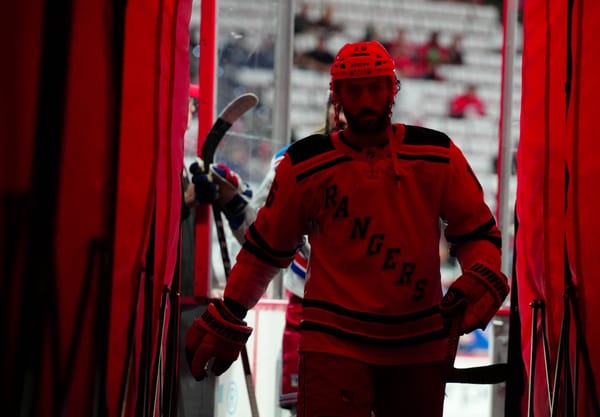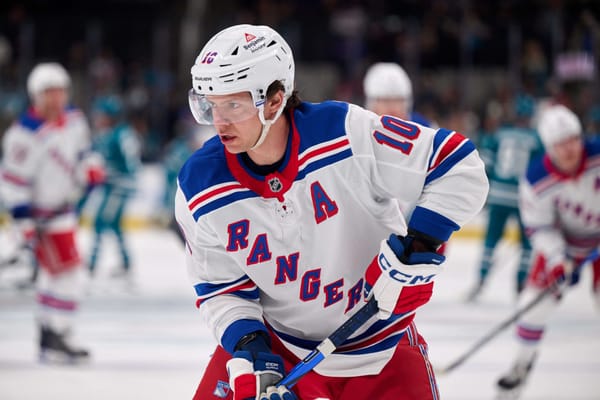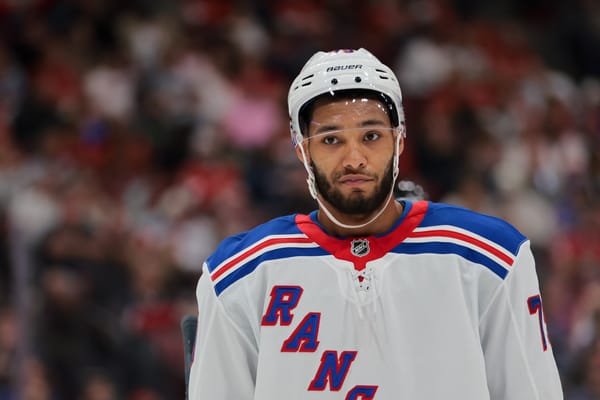It’s Time For Jeff Gorton To End The Suffering
Editor’s note: Going to drop this line a few times at the top over the next few days/weeks but if you missed it Mike and I have moved the podcast over to the Vox Podcasting Family! You can listen to the first episode (Ep. 122) here) and bookmark the landing page.
I recently purchased Stardew Valley for the Switch. For those of you who don’t know, Stardew Valley is an open-ended RPG farming simulation that Deputy Editor Mike Murphy calls “therapy the game.”
The game is based around four seasons, different growth patters in each one, and how to make as much money as possible. There’s a mine you can explore, a community center to fix up, and, of course, secrets to find. It’s a glorious little game that I’ve been able to play when the baby is asleep on my chest, or during Rangers’ slaughters, or, most recently, as a way to avoid stupid Twitter fights with the same ten people who recycle the same damn opinions.
I’m about to finish my first year in the game where the final season of said year is winter. Nothing really grows in the winter, so it’s a chance to expand your farm, upgrade your tools, and prepare for the upcoming year of growth. I learned to make sure a fair amount of my crops each season were of the variety that continued to produce after harvest, even if the one-off crops sold for more up front, to ensure I had a consistent source of income. I learned which crops sold for what, and am prepared to go into the start of each season with more money so I can plant bigger crop-loads during the up-front growing seasons.
This winter, I’ve focused on building as many bee houses (for honey) and kegs (for beer, pale ale, and wine) as possible so I can expand my empire year round (since kegs produce in the winter). I have spent a far amount of time gathering the resources to make a preserve jar where I’ll make jam and pickles all year as well. I’ve already planted fruit trees so that I can save the fruits to make said jam in the winter. In year two I’m going to get a coop and hatch some chickens so I can make eggs and mayonnaise. It’s all neat and tidy, and it’s consistently evolving as I learn more, can do more, and realize what I’m doing wrong.
So, how does this connect to the New York Rangers?
This year the Rangers elected to plant the seeds of Tony DeAngelo, Neal Pionk, Filip Chytil, Brett Howden, and sort of Lias Andersson. But much like how you need to water your seeds every day in Stardew Valley for them to grow, you need to play your players in hockey to help them develop. Pionk and Howden were given tons of time and energy mostly from the get-go, maybe even too much. We’re getting to a place of more consistency with Chytil. Andersson took a few swipes at things but, for reasons both in and beyond his control, is now growing in Hartford. DeAngelo? Well like I said, seeds won’t grow if you don’t water them.
We all knew this was going to be a rough year in terms of the wins and losses. The fact that the Rangers have the lowest ROW in the NHL shouldn’t be a surprise. Nor should the recent three-game stretch where the team was outscored 18-3 where two of those goals came in the 7-2 drubbing against the Penguins. The only surprise of the season came from that 11-game stretch where the team went 9-1-1 earlier in the year and began to convinced some very smart people that just maybe this team had enough in it to make the playoffs. If those notions still existed going into last week they shouldn’t now; not that they should have in the first place, but Henrik Lundqvist is a hell of a drug.
The team’s collective possession and underlying metric numbers have been nosediving since roughly the 16-game mark. The below is a little dated but still proves the point well enough:
#NYR splits (5v5, adjusted):
— Rob Luker (@RLuker12) January 2, 2019
Games 1-15: 47.12 CF%, 49.81 xGF%
Games 16-38: 43.99 CF%, 45.87 xGF%
Forward injuries did not help, but I think the real story is the Defense. Shattenkirk and Claesson start seeing less TOI, while Staal-Pionk see more, along with Skjei.
David Quinn has experimented with the forwards and the defense to no avail. Some of his decisions have been smart, others have been borderline insane (the DeAngelo situation comes to mind, as does the Staal-Pionk pairing being used in a consistent fashion, and Chytil playing within ten feet of Cody Mcleod). Still, at least for now, I see Quinn as someone who is trying to learn his own footing in this world as a rookie NHL coach, asmuch as a rookie player in the league would be.
For players like Pavel Buchnevich, Chytil, Pionk, and now even Jimmy Vesey, the Quinn Bin has been a quick stop on the road to playing time and development. When Buchnevich was scratched earlier in the year, he said Quinn took out time to meet with him, explain his expectations, show Buchnevich what he was and was not doing, and help him get where he needed to go. We know for a fact that wasn’t happening before, but the decisions still irk many (at times myself included) since, well, you can’t know what you don’t know and we don’t see behind that curtain.
And yet, there’s a perfectly reasonable ability to wonder if some of these decisions are coming from the stance of future trades. Is it possible McQuaid is playing as much as he is so the Rangers can get any value for him? Is the usage of Mats Zuccarello is so heavy for the same reason? Same goes for Brendan Smith? All of those guesses aside, it’s time for Jeff Gorton to mercy-kill this season and end this.
It’s well known the Rangers have committed to the rebuild — further re-enforced by a series of stories on the matter by Larry Brooks of the New York Post — despite a few thoughts that maybe Hayes was playing good enough to earn an extension, or the far less logical possibility they’d find a way to keep Zuccarello. The Rangers’ nosedive isn’t showing new information, but it’s far more noticeable now, and that probably means the vultures are going to be circling. Elliotte Friedman once said, “when things are going bad, you get thrown anvils instead of lifejackets,” and that’s true more than ever. Zuccarello is openly unhappy that he’s going to be traded, and it’s impacting his play. The value Gorton could have gotten from his is far more impacted by his 14 points in 28 games this year, but the comments don’t help either. Hayes, at the very least, is having a career season that is rocketing his trade value upwards.
But that process needs to start now, specifically for Zuccarello. The Rangers owe Zuccarello enough that they need to speed up the exit strategy for the fan favorite if his life is being made miserable by sitting and waiting. While it is Gorton’s job to get as much for his assets as he can, Zuccarello isn’t helping anyone with his play and he’s clearly letting the situation get to him. It might be best for all parties involved if Gorton simply told other general managers he was taking best offers and evaluated from there. For all we know he might be there already — but again, you don’t know what you don’t know.
Hayes is a different case. While I am a huge believer in taking a deal you like when you get it — like what the Rangers did with Michael Grabner last year — and that waiting can backfire — like what happened with Cam Talbot — there is probably a little showmanship here. Hayes is pacing out to a 70-point season, and has noticeably been the Rangers’ best forward most nights. He’s been a monster in all three zones, and is impacting play the way someone of his skillset should be. There is a belief Gorton should wait things out with Hayes until the deadline so suitors will be fever-pitched and all grouped together. This strategy has its advantages, but it’s also very risky since Hayes has to be traded, and a 2 p.m. on trade deadline day the other general managers know that too. Plus, players like Matt Duchene and maybe Mark Stone might be on the market, as well as other elite-level rental options. And I’m sure Gorton wants to avoid the headache of negotiating a deal for one of his players while other elite players are on the market, like last deadline with Erik Karlsson.
The bigger point here? Things can’t get worse than they already are.
Hayes needs to be moved to make room for Andersson in the top-nine where he can learn the speed of the NHL unhindered. Zuccarello needs to be moved so he can stop worrying about where he’s about to be traded. McQuaid needs to be traded or even outright waived since DeAngelo needs time to play and, well, the McQuaid trade was a disaster from the start. And if DeAngelo has done something behind the scenes to warrant this treatment, then he either needs to be waiver or traded — for pennies if that’s the case then so be it, since the team has tanked what little value he came with anyway. Fredrick Claesson is waiting for a consistent role too, you know.
Or, perhaps, John Gilmour?
Gilmour should 100% see time in the NHL for the rest of the season based on last year. pic.twitter.com/vk2e3G9S0p
— Rob Luker (@RLuker12) January 8, 2019
From this point forward, development needs to take the focus, as Tom pointed out here. Part of the issue with guys like Chytil, Howden, and Andersson is Hayes’ presence is a, rightful, roadblock that won’t be resolved until he’s playing in another jersey. And even then there might not be enough spots for all of them — especially if you want to avoid one center becoming a fourth line staple. But it will free up room and it will make things easier. If Zuccarello is gone as well then maybe Andersson or Chytil plies their trade on the wing. Or maybe Ville Meskanen — who as of this writing has 24 points in 37 games — can get a cup of coffee with the big club. Or maybe they bring back Vinni Lettieri (who has 19 points in 18 games).
Or maybe they stick with what they have. That point doesn’t matter as much, at least not yet. Until we see returns from the trades, we won’t know if there’s an infusion of youth that will be available right away.
All said, the important thing is Gorton does everyone a favor and kills this year officially. Not like there’s much to save anyway.





